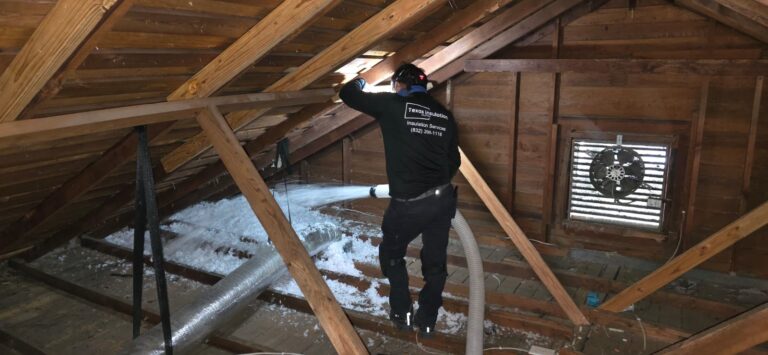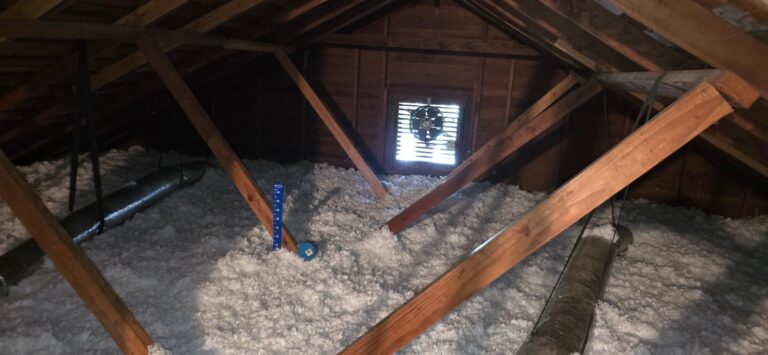-
Table of Contents
“Efficiently seal in comfort with blow fill insulation.”
Introduction
Blow fill insulation is a type of insulation material that is used to fill gaps and spaces in walls, attics, and other areas of a building. It is typically made of small particles of materials such as fiberglass, cellulose, or foam, which are blown into the desired space using specialized equipment. This method of insulation is becoming increasingly popular due to its effectiveness in reducing energy costs and improving the overall energy efficiency of a building. In this introduction, we will explore the benefits and uses of blow fill insulation.
Benefits of AttiCat Expanding Blown-In Insulation for Your Attic
Blow fill insulation, also known as blown-in insulation, is a popular method of insulating attics. It involves using a machine to blow loose insulation material into the attic space, filling in any gaps and creating a layer of insulation that helps to regulate the temperature in your home. One type of blow fill insulation that has gained popularity in recent years is AttiCat expanding blown-in insulation. In this article, we will discuss the benefits of using AttiCat expanding blown-in insulation for your attic.
First and foremost, AttiCat expanding blown-in insulation is a highly effective form of insulation. It is made of tiny, fluffy fibers that are able to fill in even the smallest of gaps and crevices in your attic. This creates a seamless layer of insulation that helps to prevent heat from escaping in the winter and keeps your home cool in the summer. This means that your home will be more energy-efficient, and you will see a significant reduction in your heating and cooling bills.
Another benefit of AttiCat expanding blown-in insulation is its ability to resist moisture. Attics are prone to moisture buildup, which can lead to mold and mildew growth. However, AttiCat insulation is made of inorganic materials that do not absorb moisture. This means that it will not promote the growth of mold or mildew, keeping your attic and home safe and healthy.
Furthermore, AttiCat expanding blown-in insulation is a more environmentally friendly option compared to other forms of insulation. It is made of recycled materials, such as paper and cardboard, making it a sustainable choice for homeowners. Additionally, the installation process of AttiCat insulation produces minimal waste, reducing its impact on the environment.
One of the most significant benefits of AttiCat expanding blown-in insulation is its ease of installation. Unlike other forms of insulation, which may require professional installation, AttiCat insulation can be easily installed by homeowners themselves. The process involves using a machine to blow the insulation material into the attic space, which can be done in a matter of hours. This not only saves you time but also money, as you will not have to pay for professional installation services.
Moreover, AttiCat expanding blown-in insulation is a great option for older homes with existing insulation. Over time, traditional insulation materials, such as fiberglass, can settle and become less effective. However, AttiCat insulation is designed to expand and fill in any gaps, ensuring that your attic is properly insulated. This makes it a cost-effective solution for homeowners who want to improve the insulation in their older homes.
In addition to its practical benefits, AttiCat expanding blown-in insulation also offers improved comfort for homeowners. By creating a barrier between your home and the outside elements, it helps to regulate the temperature and reduce drafts. This means that your home will feel more comfortable, no matter the season.
In conclusion, AttiCat expanding blown-in insulation offers numerous benefits for homeowners looking to improve the insulation in their attics. It is highly effective, resistant to moisture, environmentally friendly, easy to install, and offers improved comfort. If you are considering insulating your attic, AttiCat expanding blown-in insulation is definitely worth considering. Not only will it save you money on energy bills, but it will also make your home a more comfortable and healthy living space.
How to Properly Install AttiCat Expanding Blown-In Insulation in Your Attic

Blow fill insulation, also known as blown-in insulation, is a popular choice for insulating attics. It is a cost-effective and efficient way to improve the energy efficiency of your home. However, proper installation is crucial for it to work effectively. In this article, we will discuss how to properly install AttiCat expanding blown-in insulation in your attic.
Before we dive into the installation process, let’s first understand what AttiCat insulation is. It is a type of blow fill insulation made of fiberglass fibers that are blown into the attic using a machine. The fibers expand and create a thick layer of insulation, providing excellent thermal resistance. This type of insulation is ideal for attics with irregular shapes and hard-to-reach areas.
The first step in installing AttiCat insulation is to prepare your attic. Make sure to wear protective gear, such as a dust mask, goggles, and gloves, as the insulation fibers can irritate the skin and eyes. Also, cover any openings or vents in the attic to prevent the insulation from escaping.
Next, you will need to rent an AttiCat insulation blowing machine from your local home improvement store. The machine is easy to use and comes with instructions, but it is always a good idea to watch a tutorial video beforehand to familiarize yourself with the process.
Once you have the machine, it’s time to start the installation process. Begin by loading the insulation into the machine’s hopper. The machine will break up the insulation and blow it into the attic through a long hose. It is essential to maintain a consistent flow of insulation to ensure even coverage.
Start at the farthest corner of the attic and work your way towards the attic entrance. Use the hose to blow the insulation into the corners and edges of the attic, making sure to cover all areas evenly. It is crucial to maintain a consistent depth of insulation throughout the attic, typically between 12-14 inches.
As you move along, use a rake or broom to spread the insulation evenly and avoid any gaps or low spots. It is also essential to avoid compressing the insulation as it can reduce its effectiveness. If you come across any obstacles, such as pipes or wires, make sure to work around them and not cover them with insulation.
Once you have covered the entire attic, use a measuring tape to ensure that the insulation is at the recommended depth. If needed, you can add more insulation to achieve the desired thickness. However, be careful not to overfill the attic as it can cause the insulation to settle and create gaps over time.
After you have finished installing the insulation, clean up any excess insulation and return the machine to the rental store. It is also a good idea to check the attic periodically to make sure the insulation is still at the recommended depth and has not settled or shifted.
In conclusion, installing AttiCat expanding blown-in insulation in your attic is a relatively simple process that can significantly improve the energy efficiency of your home. However, it is crucial to follow the proper installation techniques to ensure maximum effectiveness. By preparing your attic, using the right equipment, and maintaining a consistent depth of insulation, you can enjoy a well-insulated and energy-efficient home.
Comparing AttiCat Expanding Blown-In Insulation to Other Types of Attic Insulation
When it comes to insulating your attic, there are several options available on the market. One popular choice is blow fill insulation, which is a type of expanding blown-in insulation. This type of insulation is known for its effectiveness in reducing energy costs and improving the overall comfort of a home. In this article, we will be comparing AttiCat expanding blown-in insulation to other types of attic insulation, to help you make an informed decision on which option is best for your home.
Firstly, let’s take a closer look at AttiCat expanding blown-in insulation. This type of insulation is made from fiberglass and is installed using a machine that blows the insulation into the attic space. The insulation expands to fill any gaps or voids, creating a seamless layer of insulation. This method of installation ensures that every nook and cranny of the attic is covered, providing maximum efficiency in terms of insulation.
One of the main advantages of AttiCat expanding blown-in insulation is its ability to provide a high R-value. R-value is a measure of an insulation material’s resistance to heat flow, and the higher the R-value, the more effective the insulation is. AttiCat has an R-value of 3.7 per inch, making it one of the most efficient types of insulation on the market. This means that it can effectively keep your home warm in the winter and cool in the summer, reducing the need for excessive heating and cooling, and ultimately saving you money on energy bills.
Another benefit of AttiCat expanding blown-in insulation is its ability to reduce noise levels. The dense and compact nature of this insulation helps to absorb sound, making it an excellent choice for homes located in noisy areas or near busy roads. This can greatly improve the overall comfort of your home, creating a peaceful and quiet environment for you and your family.
Now, let’s compare AttiCat expanding blown-in insulation to other types of attic insulation. One popular alternative is fiberglass batt insulation, which is installed in large sheets or rolls. While this type of insulation is also made from fiberglass, it is not as effective as AttiCat in terms of R-value. Fiberglass batt insulation has an R-value of 3.2 per inch, which is lower than AttiCat’s R-value of 3.7 per inch. This means that you would need a thicker layer of fiberglass batt insulation to achieve the same level of insulation as AttiCat, making it a less efficient option.
Another type of attic insulation is cellulose insulation, which is made from recycled paper products. While cellulose insulation has a higher R-value of 3.8 per inch, it is not as effective as AttiCat in terms of installation. Cellulose insulation can settle over time, leaving gaps and voids in the insulation layer, which can reduce its effectiveness. AttiCat, on the other hand, does not settle and maintains its density over time, ensuring maximum efficiency.
In terms of cost, AttiCat expanding blown-in insulation may be slightly more expensive than other types of insulation. However, the long-term savings on energy bills and the improved comfort of your home make it a worthwhile investment. Additionally, AttiCat is a more environmentally friendly option, as it is made from recycled materials and does not contain any harmful chemicals.
In conclusion, AttiCat expanding blown-in insulation is a highly efficient and effective option for insulating your attic. Its high R-value, noise reduction capabilities, and long-term cost savings make it a superior choice compared to other types of attic insulation. If you are looking to improve the energy efficiency and comfort of your home, AttiCat expanding blown-in insulation is definitely worth considering.
Q&A
Q: What is blow fill insulation?
A: Blow fill insulation is a type of insulation material that is blown into walls, attics, and other spaces using specialized equipment. It is typically made of fiberglass, cellulose, or mineral wool and helps to reduce heat loss and improve energy efficiency in buildings.
Q: How is blow fill insulation installed?
A: Blow fill insulation is installed using a blowing machine that breaks up the insulation material into small pieces and then blows it into the desired space through a hose. The installer will typically start at the top of the space and work their way down, ensuring even coverage.
Q: What are the benefits of blow fill insulation?
A: Blow fill insulation offers several benefits, including improved energy efficiency, reduced heating and cooling costs, and better soundproofing. It can also help to prevent drafts and improve indoor air quality by reducing the infiltration of outside air. Additionally, it is a cost-effective and environmentally friendly insulation option.
Conclusion
In conclusion, blow fill insulation is a highly effective and efficient method of insulating homes and buildings. It offers numerous benefits such as improved energy efficiency, noise reduction, and moisture control. Its installation process is quick and easy, making it a popular choice for both new construction and retrofitting projects. Additionally, blow fill insulation is environmentally friendly and can help reduce energy costs in the long run. Overall, it is a cost-effective and practical solution for improving the comfort and energy efficiency of any structure.






